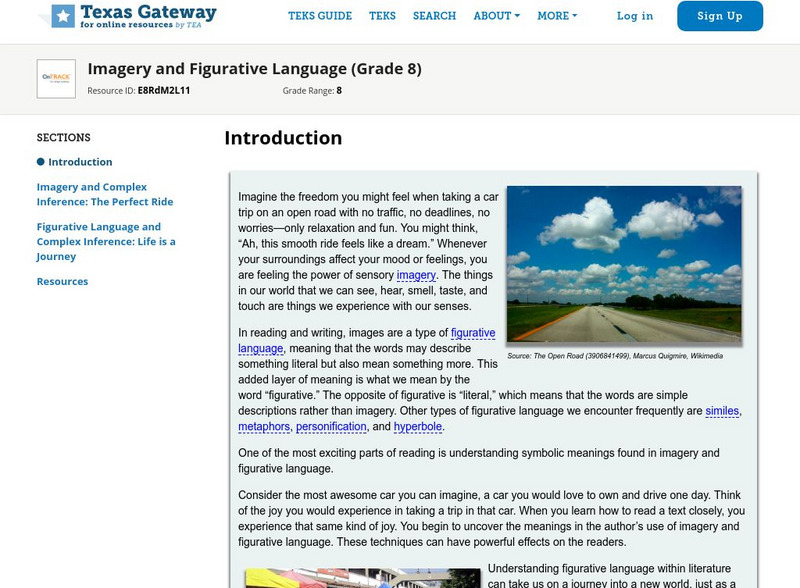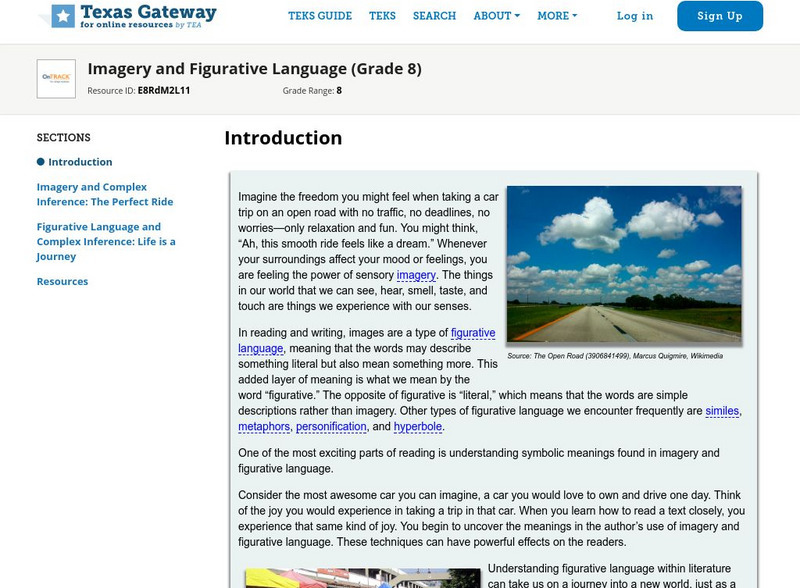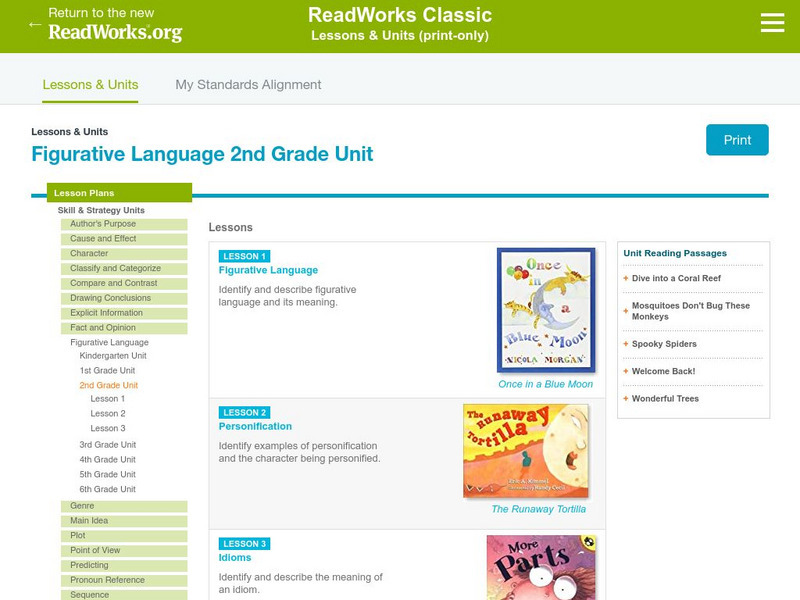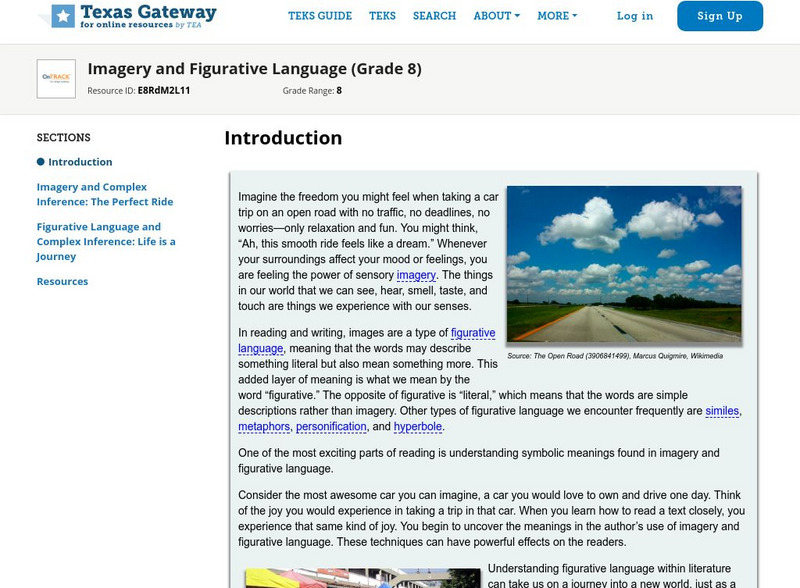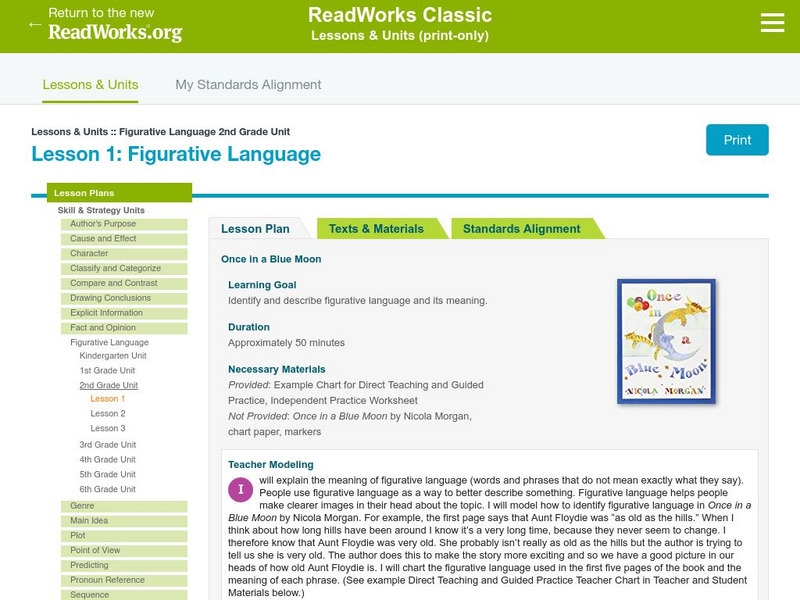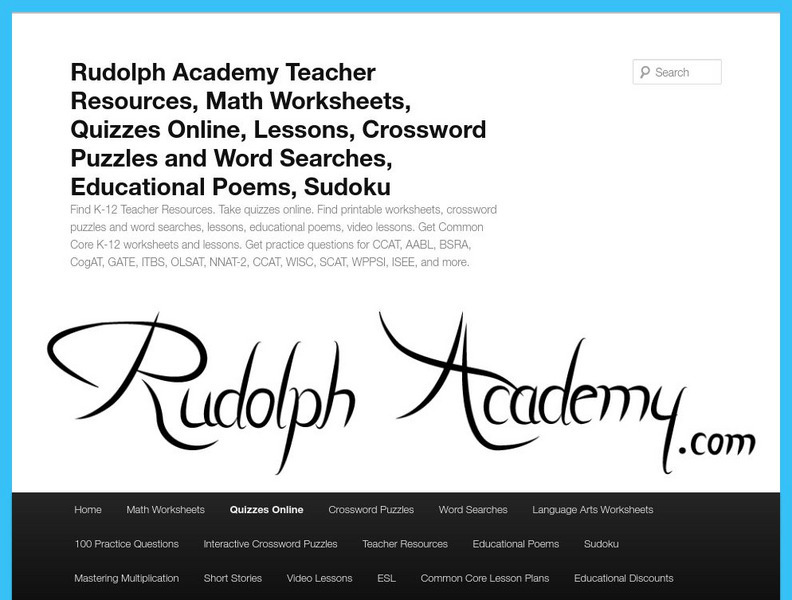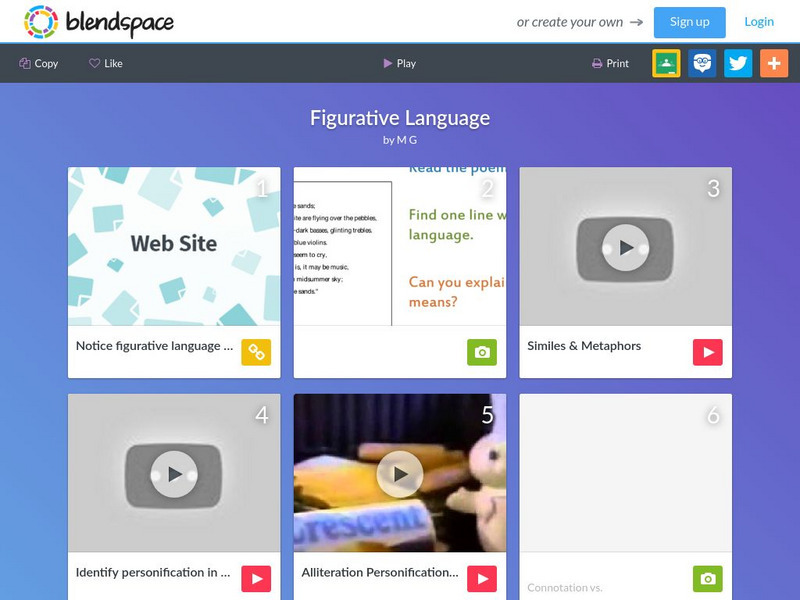Hi, what do you want to do?
New York State Education Department
TASC Transition Curriculum: Workshop 4
Why is it important to use precise language? Participants explore this question in the fourth activity in a series of 15 on effective instruction. Perfect for all content areas, the activity promotes appropriate language choice through...
William & Mary
Inferential Reading Comprehension Considerations Packet
Don't forget to read between the lines! Educators learn tips and activities to help scholars learn to infer to increase reading comprehension. Activities suggested include think alouds, backwards words, and who's who. the packet includes...
South Carolina Educational Television
Know It All: Using Figurative Language to Shape Meaning and Style
The students will be able to identify different types of figurative language in a story and explain how the author uses figurative language to shape the meaning and style of the story.
Better Lesson
Better Lesson: Go Figure With Figurative Language It Helps With Predicting!
In this lesson, students will use figurative language, digital tools, and illustrations to write a story. The teacher will model how to use an app that has onomatopoeia to create a story with a good beginning, middle, and end. A video...
Texas Education Agency
Texas Gateway: Imagery and Figurative Language (English 7 Reading)
This lesson, focuses on three ways to use figurative language: to create imagery, to appeal to the senses (using sensory detail), and to suggest mood.
Texas Education Agency
Texas Gateway: Imagery and Figurative Language (Grade 6)
This lesson focuses on the use of imagery and figurative language in writing to aid understanding and create images in the mind.
Texas Education Agency
Texas Gateway: Imagery and Figurative Language (Grade 8)
In this lesson, students learn how to make complex inferences and use textual evidence such as imagery and figurative language to support understanding.
PBS
Pbs Learning Media: Literary Elements and Techniques: Figurative Language
Discover how authors use figurative language to enhance their writing and explore the differences between similes and metaphors in this animated video [3:37] from WNET. Discussion questions below help students to further apply their...
ReadWriteThink
Read Write Think: Finding Figurative Language in the Phantom Tollbooth
Contains plans for four lessons that use The Phantom Tollbooth by Norton Juster to teach about figurative language. In addition to objectives and standards, this instructional plan contains links to handouts and to sites used in the...
ReadWriteThink
Read Write Think: Figurative Language Awards Ceremony
Contains plans for five to seven lessons that teach about figurative language like similes, metaphors, and personification by asking students to write award acceptance speeches that incorporate them. In addition to objectives and...
Texas Education Agency
Texas Gateway: Imagery and Figurative Language
In this lesson, you will learn how to make complex inferences and use textual evidence such as imagery and figurative language to support understanding.
Read Works
Read Works: Grade 2: Three Lesson Unit: Figurative Language
[Free Registration/Login Required] A series of three lesson plans designed to teach students to identify and explain the meaning of figurative language including personification and idiom. Lessons are based on the books Once in a Blue...
Texas Education Agency
Texas Gateway: Imagery and Figurative Language (Grade 8)
Make complex inferences and use textual evidence such as imagery and figurative language to support understanding.
Other
Travis Unified School District: Figurative Language Terms in Julius Caesar [Pdf]
A one-page chart listing figurative language terms used in The Tragedy of Julius Caesar, along with definitions and examples.
McGraw Hill
Mc Graw Hill: Informational Text: Craft and Structure: Figurative Language
Explains what figurative language is and how to determine its meaning. Also provides a practice exercise.
Alabama Learning Exchange
Alex: Plath, Personification, and Figurative Language
This project based activity will use Sylvia Plath's poem, "Mirror", to examine the use of personification and figurative language. The activity may also incorporate the use of technology to produce a multimedia project. This allows...
ReadWriteThink
Read Write Think: Onomatopoeia: A Figurative Language Mini Lesson
Contains plans for a minilesson that teaches about onomatopoeia using Edgar Allan Poe's poem "The Bells." In addition to objectives and standards, this instructional plan contains links to sites used in the lesson as well as assessment...
Read Works
Read Works: Fourth Grade: Three Lesson Unit: Figurative Language
[Free Registration/Login Required] A lesson plan, based on In a Pickle and Other Funny Idioms by Marvin Terba, in which students learn how understand idioms and use them to explain the plot and to make predictions. With free login, users...
Read Works
Read Works: 2nd Grade Lesson: Figurative Language
[Free Registration/Login Required] A lesson in which students use the book Once in a Blue Moon by Nicola Morgan to learn to identify and interpret the meaning of figurative language in a fiction text. Lesson includes direct teaching,...
Quizlet
Quizlet: Flashcards: Figurative Language Level 1
Practice learning figurative language using these audio-enabled flashcards with literary terms and their definitions. Also provided is a list of terms and definitions (audio available) and links to games and a test. Java is required....
Other
Rudolph Academy: Figurative Language Quizzes and Practice Exercises
This site offers a multitude of figurative language quizzes (some by grade level), a PowerPoint presentation and links to much more. It features a 30 question quiz asking students to either read or listen to statements and then select...
TES Global
Blendspace: Figurative Language
A fifteen-part learning module with links to images, texts, and websites to use while learning about figurative language including simile, metaphor, idioms, and more.
TES Global
Blendspace: Figurative Language
A thirteen-part learning module with links to websites, images, videos, and texts to use while learning about figurative language.
TES Global
Blendspace: Learning Figurative Language Rap
A learning module with twenty-four links to websites, images, texts, and videos to use while learning about figurative language.











